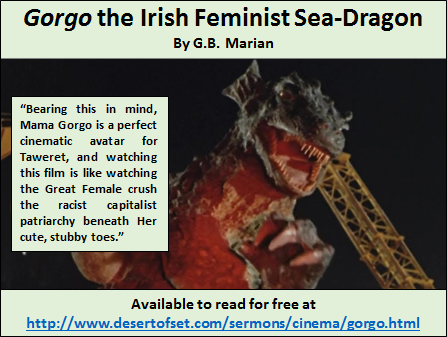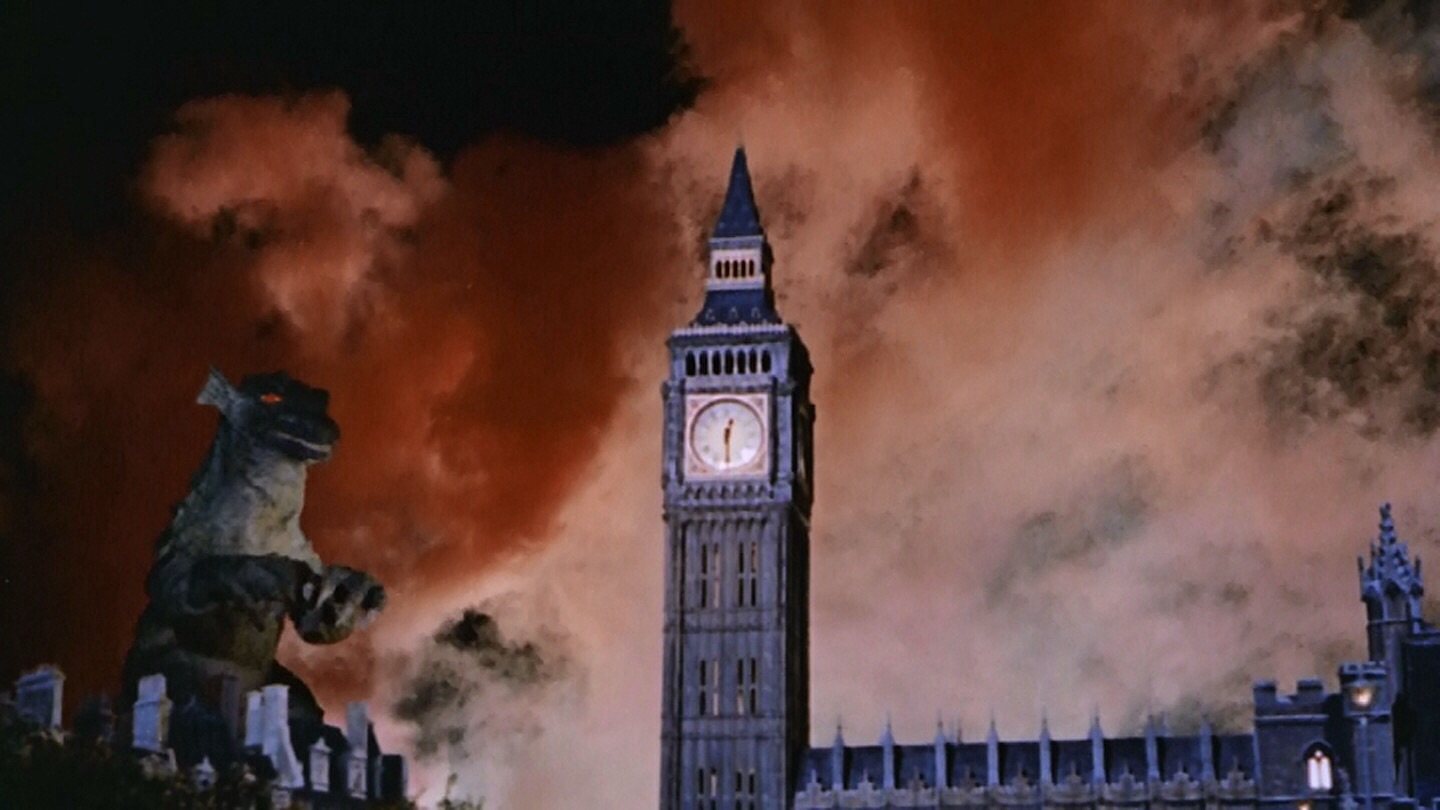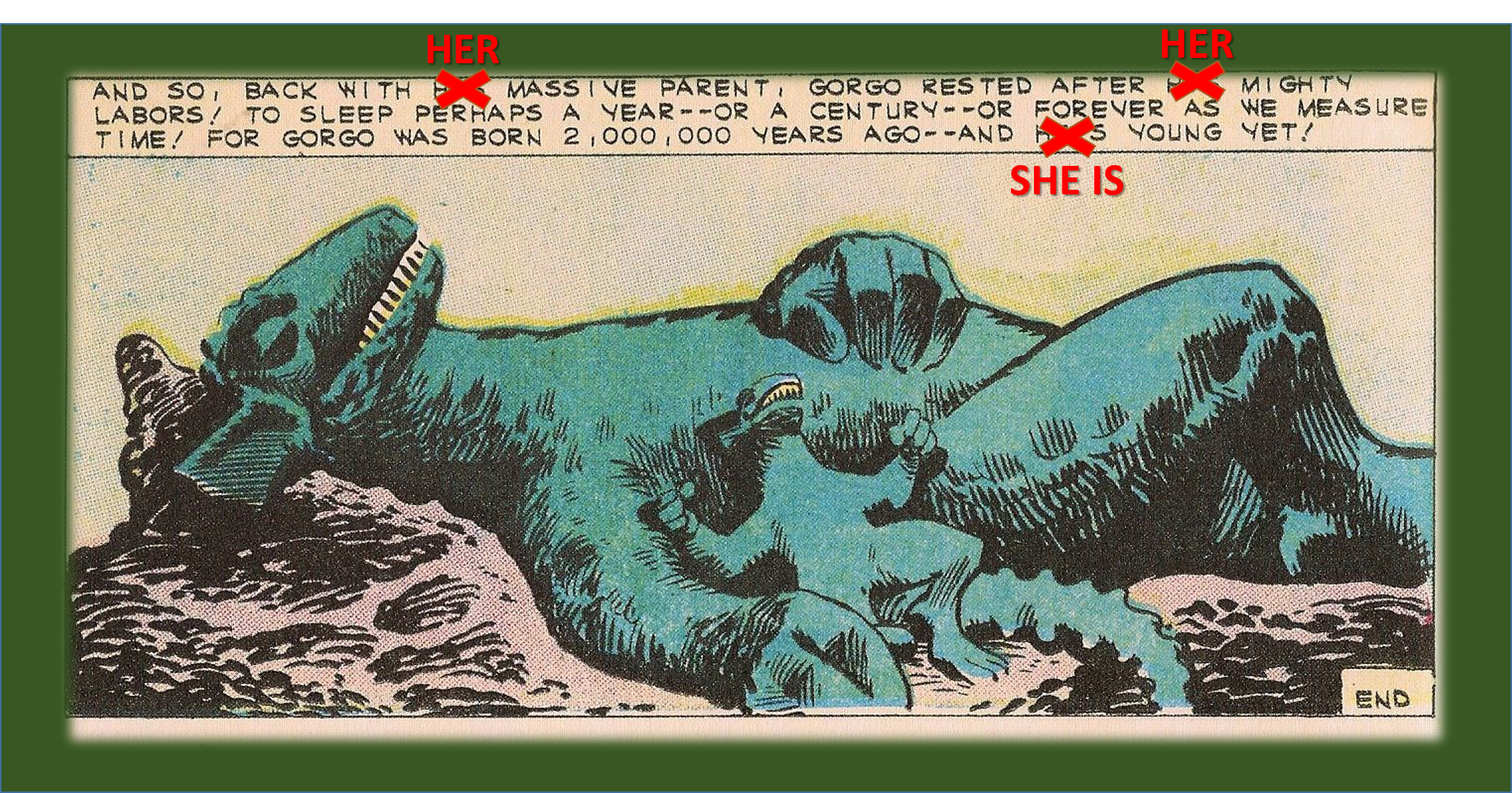

In Gorgo (1961), two guys named Sam and Joe are traveling the British seas, looking for gold and other precious junk on the ocean floor. Their ship gets damaged during a weird volcanic eruption that happens in the middle of the sea for no apparent reason, and they end up having to stay on an island off the coast of Ireland for a few days. While repairing their ship, Sam and Joe start to notice that the people of this island seem to be hiding something. Well, that something turns out to be a giant bipedal lizard with big floppy fins for ears. Sam and Joe decide to capture the creature, and when they do, the Irish government implores them to give the beast to the University of Dublin for scientific research. Unfortunately, our protagonists decide to bring the reptile to Dorkin’s Circus in London instead, where they make a shit-ton of money off the poor creature. The joke’s on them, though, because they soon learn that “Gorgo” (the name Dorkin gives to the creature, which is taken from the three Gorgons in Greek mythology) is not the only one of its breed. It’s really just a baby, in fact, and its mother—who is significantly larger and meaner—is now on her way to file one hell of a grievance against the entire city of London.
That’s pretty much the entire plot to the film right there, and considering its year of release, we’re dealing with some pretty predictable stuff. For the most part, Gorgo is largely a remake of King Kong (1933), save that its giant monster is of the saurian persuasion. However, there are several things that distinguish this kaiju film from all of its contemporaries. At the most obvious level, it’s not Japanese but British, and it provides some interesting insight into the British sociopolitical situation that existed when it was made. When Sam and Joe arrive at the Irish island with their crew, they seek help from the locals. But the locals will only respond to them in Gaelic, even though it’s clear that they understand English. Sam and Joe also learn that the harbormaster has been salvaging archaeological finds from the ocean, and they bully the dude into giving them all of his loot as payment for capturing Gorgo. Later on, when they decide to sell Gorgo to the London circus, they are effectively giving the Irish government the middle finger. That’s not once but twice in the same film where Ireland gets screwed over by Englishmen, who rob the Irish not only of their history (i.e., the archaeological finds) but of their own real-life dragon as well.
I first saw Gorgo when I was five or six years old. I had already seen a lot of giant monster flicks by that point, and in most of them, the “ethnic” people are usually people of color. This goes all the way back to King Kong (1933), which unfortunately depicts black people as savages whom the white characters could easily exploit. But this was the first time I had ever seen a situation where it was white people being absolutely fucking racist against other white people. Seeing the English dudes mistreat the Irish dudes in Gorgo was my introduction to subjects like Hibernophobia and the Troubles of Northern Ireland. I am also indebted to the film for providing me with my first exposure to Gaelic language and culture.
But there’s another subtext in this film. So there’s this Irish kid named Sean, and he’s the only character who sympathizes with the monsters. He even becomes a stowaway on Sam and Joe’s ship, hoping to free Gorgo out at sea. The kid gets caught, but what do you think happens after that? Sam and Joe decide to let Sean live with them, that’s what. And yes, I said “with them.” With only a few brief exceptions, these two men spend the entire movie together; and the body language they use around each other at home is most interesting. There’s one scene where Sam and Joe are comforting little Sean while he tries to go to sleep, and Joe stands at the head of the bed in a fatherly pose while Sam sits on the mattress beside Sean. Then there’s another scene where Sam and Joe have a squabble over a carnival worker who’s accidentally killed by Baby Gorgo; Sam’s worried about the guy’s wife and kids, and Joe promises him that he’ll send them some money. There’s even a scene where the two of them are introduced as “Joe Ryan and his partner, Sam Slade”—and while that kind of terminology didn’t have the same connotation in 1961 that it has today, it’s hard not to imbue it with contemporary significance. It’s also telling that there isn’t a single girl or woman in the entire cast, and that when one of the adult characters starts to side with Sean about setting Gorgo free, it’s Sam (the “motherly” father). In other words, it’s totally believable to me that Sam and Joe are a couple, that they’ve adopted Sean, and that the three of them have become a family.

I say Gorgo has no women in it (aside from a few here or there among the extras during the final act), but there is at least one female in the film (if not two), and that’s Mama Gorgo. It’s never specifically mentioned at any point that she’s got two XX chromosomes, but I think we can safely assume that this is true; for how else can we explain Baby Gorgo? There are such things as the New Mexico whiptail, a species of lizard that is entirely female and that reproduces through parthenogenesis. It seems likely to me that Baby Gorgo is female as well, given that Dorkins names her after the Gorgons of Greek mythology (all of whom are ladies). Gorgo was also the name of a famous Queen of Sparta who lived and ruled during the 6th and 5th centuries BCE. So any way you slice it, it would seem that the giant lizards in Gorgo are the only female characters in the entire film. This would make sense in light of certain combat myths like the Enuma Elish, for just as Marduk used his masculine strength to slay his saurian mother Tiamat and create the universe from Her corpse, so do Sam and Joe try to create a multimillion dollar empire with the female Irish sea dragon they’ve captured. But things don’t go quite so well for them as they did for ol’ Marduk, which brings us to the next reason why Gorgo shouldn’t be dismissed as a mere King Kong cash-in.

I’ve always found the original 1933 King Kong too horrific to watch, because it’s about people committing acts of animal cruelty and not having to pay any real consequences for doing so. While many viewers sympathize with the titular giant ape, there is no indication in the film itself that we’re supposed to; Kong is presented as being just a big dumb animal who has to die so the damsel in distress can live to marry the dashing male hero. None of the characters mourn for Kong, and no one acknowledges that removing him from his natural environment and exploiting him was wrong (or at least, not until the remakes came along). Such was the general attitude audiences had toward giant monsters until 1954, when Ishiro Honda gave us the original Godzilla. The monster in that film also had to die, but its death is treated more like a funeral; the audience is actively encouraged to sympathize with it and to consider the aftermath of all the violence that happens in the film. Gorgo, in contrast, is the first kaiju film in which the monsters are not only sympathetic, but victorious. There’s nothing quite so satisfying as seeing Mama and Baby Gorgo swimming back home to Ireland at the end of the film, and it wasn’t long after their victory that Mothra, Godzilla, King Kong, and the giant turtle Gamera were each re-imagined as kid-friendly superheroes.

Returning to my previous point, the conflict in this film would seem to exist between two different same-sex families: (1) a single mother and her little girl (the Gorgos), and (2) two men and their son (Sam, Joe, and Sean). Neither of these two families is “normal” according to “traditional” patriarchal standards, and yet the film never tries to “punish” them for this. As mentioned earlier, the Gorgos are reunited and get to go home, alive and happy; but even the human family turns out okay in the end. They also share a collective character arc; at first it’s just Sam and Joe, and all they care about is fame and money. Then they adopt Sean, the little Irish animist who sees the giant lizards as people. Over time, Sean’s “motherly” father Sam starts sympathizing with the big beasties as well. Joe—the “fatherly” dad—remains an asshole for most of the story, but then he redeems himself during Mama Gorgo’s attack on London. He protects Sean amidst all the destruction, and they are both eventually re-united with Sam. Based on how Joe behaves earlier in the film, you would expect this character to try and save his own skin while leaving the kid to die (and then be promptly eaten by the monster for being a dick). Not so with Joe; he sees the light, chooses his kid over his own self-preservation, and actually proves himself to be a stand-up dude.
Gorgo does have its flaws, though most of them are the kind I tend to overlook. For example, the writing isn’t as sharp as it could have been; most of the character development is restricted to the first two acts (which tends to bore the hell out of most viewers), while most of the action occurs during the final act (which causes the film to forget about its human characters almost entirely by that point). These things don’t really bother me, though, because I think most everything else about the film works. The only serious criticism I have about Gorgo is the fact that during its final 18 minutes, it suddenly introduces a news reporter character who narrates every single detail about Mama Gorgo’s parade through London. This segment is so glaringly unnecessary, it’s virtually impossible to ignore it. The first 60 minutes of the story are easy enough to follow, so why the hell did anyone think the last 18 needed a narrator?
Another thing I love about this movie is the fact that it makes me think about Taweret, the hippo fertility goddess. Taweret is like a benign chaos monster; instead of being killed to save (or create) the world, She kills other monsters that threaten the future of the world. Bearing this in mind, Mama Gorgo is a perfect cinematic avatar for Taweret, and watching this film is like watching the Great Female crush the racist capitalist patriarchy beneath Her cute, stubby toes. If you’re Pagan and you love animals (especially gigantic saurian beasties with wiggly ears), I bet dollars to donuts you will enjoy Gorgo.

